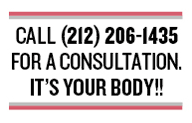
Dr. Stanley West is the author of The Hysterectomy Hoax, published in January, 1994 by Doubleday. In it he explains why 90 percent of all hysterectomies are unnecessary, and describes all the treatment options available to every woman, no matter what age.
Questions?
Contact Dr. West. He will answer you promptly


Two days before [my scheduled] hysterectomy, I visited Dr. West ... [years later] I now have an 8 year old son.
–Beatrice E. Kisala, Hackensack, NJ
Know Your Body
The uterus is a muscular organ primarily designed for childbearing. This is where you will nourish and carry a baby as it grows from a tiny collection of cells to a full-term fetus, ready to emerge into the world as a healthy newborn.
The endometrium is the lining on the inside of the uterine cavity. Each month, under the influence of two hormones, estrogen and progesterone, the endometrium thickens in preparation for pregnancy. Should you conceive, it will nourish the fetus during the first few weeks of life. If pregnancy does not occur, the endometrium is shed as your menstrual period.
The cervix is the entrance into the uterine cavity through which blood and tissue flow out when you menstruate. It is also the entry way to the uterus for sperm.
The ovaries are the repository of all the eggs a women will ever have. The eggs are lodged in microscopic bubbles called follicles, which themselves produce a number of different reproductive hormones. Chief among them are estrogen, progesterone, and androgens.
The fallopian tubes are positioned between the ovaries and the uterus. Conception takes place in a tube, after which the fertilized egg begins to travel down the narrow tubal passageway toward the uterine cavity, where it will implant itself and continue to grow during the nine months of pregnancy.
The vagina is a closed canal that, under ordinary circumstances, is collapsed. However, it can expand to fit whatever is placed into it and distends to permit the delivery of a baby.
Medical science is just realizing what women have known for a long time: removing the ovaries is a direct cause of many of the physical, emotional, and sexual symptoms women experience after hysterectomy. Even if the ovaries are not removed along with the uterus, removal of the uterus often leads to the ovaries ceasing to function, which can in turn, lead to symptoms.
Of course, once a woman has a hysterectomy she will be unable to carry or birth a baby. (If the ovaries are still in tact though, she may be able to reproduce via in vitro fertilization and by utilizing a surrogate to carry the baby.) Since alternative treatments are available for almost all of the conditions for which hysterectomy is performed, women of every age need to find out all of their choices before making a decision.
A well-informed woman who understands her own body and how it works has an enormous advantage when she develops a gynecologic disorder.
Patients should always make sure all of their questions have been answered by their doctors before proceeding with any surgery.